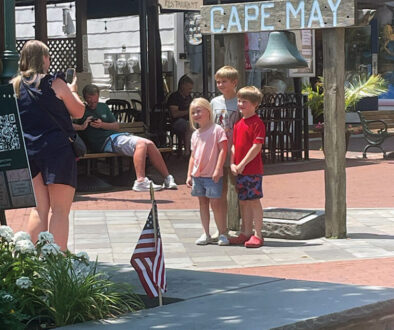Best Kept Secret
Cape May National Wildlife Refuge, Two Mile Beach Unit

“When we see land as a community to which we belong, we may begin to use it with love and respect.”
– Aldo Leopold
The Cape May National Wildlife Refuge – Two Mile Beach Unit is a tranquil and well-tended respite, covering over 500 acres of preserved land. It’s located off Ocean Drive in Wildwood Crest and is the only remaining undeveloped maritime forest/beach in New Jersey. The U.S. Fish and Wildlife Service manages it.
The entrance, Loran Road, named after the defunct Coast Guard LORAN Unit (more on that later) leads to this hidden gem. It is a haven for migratory birds, along with other wildlife—mammals, amphibians, and more. Its marshes and tidal creeks are necessary for serving as nutrient sources and spawning grounds for various fish, shellfish, and invertebrates—nature as designed.
I visited several times, in March and May. A large hand-painted sign “Cape May National Wildlife Refuge,” marks the entrance, displaying the Red Knot, its belly and face aglow with orange; black and white mottled feathers cover its back. I heard the call of birds and noticed a flurry of activity high in a cluster of trees. It was a large flock of about two dozen Blue Herons. Some were hunting for food while others were getting acquainted with one another, pirouetting or perching on tree branches. Although I’m not a bird enthusiast, just witnessing this gathering made me want to invest in high-end binoculars and a camera with a telephoto lens to capture the phenomenon. With a little research I discovered that what I had witnessed was a rookery, an area where particular birds of the same breed gather to mate and nest.
During the year, refuge volunteers and staff monitor and record bird sightings. They are the Friends of Cape May National Wildlife Refuge (FCMNWR). During the first week of March, 52 bird species were reported (lists are kept outside in weatherproof displays). As a bird novice I was astounded to discover visiting birds, among them Carolina Chickadees, Oystercatchers—even the infamous Turkey Vultures were in town—although the air was extremely cold.


Turkey Vulture sightings harken back to a time I spent on a canoe trip with my family as a young girl. I cautiously studied a flock of Turkey Vultures soaring above us. My dad and brother joked how the circling birds were looking for their next meal, as my mother and I became quite unnerved. However, I learned that the vultures are perfectly harmless, but with wingspans of six feet or more, their size can be rather intimidating!
Many trails in this dune forest are open year-round from dawn to dusk. The beach access trails—and the beach—are closed from April 1 to September 30 for migratory activity. Unusual and diverse plants and trees fill the preserve. There are host plants like milkweed peppered throughout the dunes that Monarch butterflies will lay their eggs on. The eggs hatch into a caterpillar which feeds off the milkweed, then forms a chrysalis attached to the plant. In time, a metamorphosis takes place, as the caterpillar transforms into a butterfly. The flowers, bushes, and trees growing at the preserve guarantee the fragile butterfly’s survival. During Monarch migration, in the fall, they saturate the dunes with a fluttering orange glow before takeoff on their journey to Mexico.



The visitors’ center conducts guided trail tours beginning in May and continues through September every Saturday at 9am. The center is a wealth of information, and the dedicated volunteers are happy to share their knowledge with the public. I was welcomed wholeheartedly by the FCMNWR President Mary Beth Hueter and June Karp, co-manager.
Throughout the spring and summer there are special nature themed activities for children: plant and animal identification, nature story time, and a myriad of activities like scavenger hunts. For younger children, there is pavement chalk drawing and more. There are rain barrel demonstrations and workshops, and repeating this year a plein air painting class with local artist Janet McShain.There are activities for young and old, individuals or groups.
Another fun event held twice a year is Night Sky Exploration with local astronomers. In April, I attended an event with Kevin Beare, or Cape May Astro as he’s known on his popular Instagram account. He resides in Cape May, and is a “sidewalk astronomer,” often setting up his impressive telescope around town, generally drawing curious passersby.

At the Refuge parking lot, after dusk, I was a lucky attendee among 30 stargazers. As darkness descended and the stars popped out, Kevin explained our solar system and what we were witnessing firsthand. On a screen hooked up to the telescope, we viewed the Milky Way. A bonus, within a short time: not one but three shooting stars streaked overhead. The parking lot is an ideal location because it’s remarkably dark in the spring, void of interference from Wildwood or Cape May’s lights. Another astronomy expert will present there later this year.
When visiting, keep in mind that the Two Mile Beach Unit has been part of the Cape May National Wildlife Refuge since 1989, as well as part of the U.S. Fish and Wildlife Service. It’s only a small part of a bigger parcel of over 21,000 acres of preserved land that New Jersey plans to protect on the Cape May peninsula. Note: The Cape May National Wildlife Refuge is approximately 13,200 acres alone!
The Cape May National Wildlife Refuge has three units. The Great Cedar Swamp Division is at the northern end of the refuge in Dennis and Upper Townships. This refuge connects with a state forest and the Pinelands National Reserve. The Delaware Bay Division is in Middle Township and extends along five miles of Delaware Bay. The Two Mile Beach Unit is on a barrier island with a beachfront, tidal ponds, and maritime forest in Lower Township. This refuge supports 317 bird species, 42 mammal species, and 55 reptile and amphibian species along with fish, shellfish, and other invertebrates. In 1989, the Cape May National Wildlife Refuge became an extension of the National Wildlife Refuge System. It’s one link of a vast network of refuges of the U.S. Fish and Wildlife Service and serves hundreds of thousands of migrating birds in the Atlanta Flyway.
This seaboard haven is not only vital for the Monarch butterfly migration but other butterfly species, bees, and bats that are pollinators for crops, fruit trees and more, and play a critical role in crops’ survival. Many birds arrive in the spring and remain to raise their young. In the fall, this peninsula is alive with migrating birds, particularly raptors (layman terms: hawks). There are 17 raptor species like the Red-tail Hawks, Bald Eagles, Peregrine Falcon, and Osprey.
Rules of the Preserve
Whether out for a hike or just to observe nature, always be cognizant of your surroundings. There are a few simple rules: Stay on the trails. Don’t interfere with animals or birds that you’re observing. Don’t go into cordoned-off areas.
There are valid reasons for this post. Migrating birds that have flown hundreds of miles nonstop require an area undisturbed by humans. Locating food and resources and a place to rest is essential for their survival. If there’s human interference, the birds’ first survival response is to escape but they are so exhausted that they suffer harshly, including, at times, death. In spring, nesting birds require places like this preserve to raise their young. Not until I researched the importance of the Atlanta Flyway did I understand its intrinsic value. This also pertains during the fall Monarch migration. And if you discover that the dunes are covered with the resting and feeding Monarchs, let them be. They have a long migratory flight ahead of them and this stopover is critical for their survival.

If birding or mammal spotting doesn’t interest you, there are other reasons to visit the refuge. The serenity, the sea air, and just bathing in nature will do wonders to lift one’s spirits. A preserve is a restorative area—for nature and mankind—and requires support and respect. Preserves such as these are a treasure to hold dear not only for ourselves but future generations.
Cuts by the current administration have left places like this reeling as they search for ways to keep from closing. That’s why the Two Mile Beach Unit is maintained by good citizens that give their free time; not for a paycheck, but to keep preserves like these from shutting down. They truly are the Friends of Cape May National Wildlife Refuge, and friends of nature, composed of men and women from all walks of life.
I attended a meeting calling for volunteers and was pleased with the number of people who showed up. The room was filled. Current volunteers shared their history of the unit with the audience. Some hold degrees in environmental science; others are retired teachers, nurses, photographers, writers, and more.All share the common goal to help educate adults, children, and the elderly on the importance of nature and its preservation.
Salt marshes and barrier islands have been and continue to be erased due to urban development. We must ask ourselves how many more condos and high-rise structures we need—particularly along the sea, given the fact that sea levels are rising and will continue, never to return to previous levels. Barrier islands have ceased being islands, as earth-moving equipment filled them in for developers to construct beachfront properties. Southern New Jersey realizes more than ever the critical need to save and maintain wildlife preserves such as these.
Refuge volunteers are excited to share their knowledge with visitors. Bird enthusiasts will discover that the volunteers are well-versed, and many are experts in the field. One volunteer has extensive training and knowledge in vertebrates to share.

All volunteers chip in a few hours per week—many longer. Some conduct classes for young children while others escort groups through the trails, educating them about the preserve and its diverse wildlife. Others help with the heavy lifting, trail maintenance and digging as required. Some maintain the desk, answering phones and greeting guests during public visits to the diminutive building.
The center provides free use of binoculars during nature walks, maintains a nature reference library and a small nature-themed store with books, hats, postcards, clothing and more. It’s spotless, with restrooms in the building during the season. Of course, there are outdoor facilities available when the center is closed.
Good News
The LORAN (Long Range Navigation) Unit shut down in 2010 and sat dormant for years. Previously, it was a government facility, maintained by the Coast Guard. In January 2025 there was a no-cost transfer to the U.S. Fish and Wildlife service. It includes 532 acres, including .75 miles of beachfront. This acreage also includes dunes, marshes, and woodland and will be kept indefinitely in its natural state. As of this writing, the Refuge Manager, Robin Donohue, cannot provide a timeline when the additional acreage will be open for public use, although the intent is that this preserved land will serve a similar use as the existing Two Mile Unit.
As for the dismantling of the LORAN 625-foot tower, this plan will also take time and will be managed by the Coast Guard. However, with the additional 532 acres of land to the existing 500 acres, the Two Mile Island Beach Unit refuge will total over an impressive 1000 acres of preserved land. It’s a win-win for the public and future generations, and for the wildlife, migrating birds and butterflies, the horseshoe crab and other invertebrates. The dune habitat will remain in its natural state indefinitely.
The two trails, the Marsh trail and Dune trail, are open year-round, dawn to dusk. However, the 0.7-mile-long beach portion is closed from April 1 to September 1 as a migratory refuge.
Not only do bird enthusiasts benefit, but families can take extended walks, bike in designated areas, and commune with nature. As people have more leisure time, it has been increasingly evident that preserved refuges such as these become invaluable. Forgoing staring at screens all day, society is transitioning to spending more time outdoors. Young people are more interested than ever as they understand the value of protecting their environment. Handing off preserved lands such as these to the next generation is vital to us as a species.
And a bonus is what brings us joy is attributed to not only our physical well-being but our mental health. Whether the reason for your visit to the refuge is to hike, bike, bird watch, amphibian spot, or just plain breathe the salt air, this hidden secret can be yours as you move along with the rhythms of the sea.
A Few Pointers
When watching wildlife, wear clothing with colors that blend into your surroundings, like tans and khaki. A wide brim hat and sunglasses will not only protect you from the sun but also help shield your eyes. Wear comfortable shoes, preferably neutral colors. Observe from afar using scopes or binoculars. In addition to the binoculars provided by the visitor center, there are sheltered structures along some trails that have built-in scopes for viewing wildlife. Go discover this treasure for yourself.



